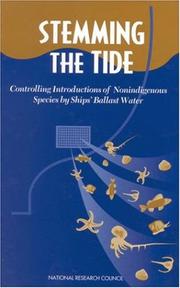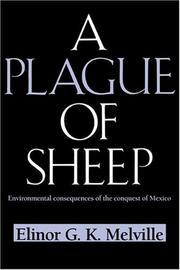| Listing 1 - 4 of 4 |
Sort by
|

ISBN: 0871697556 Year: 1985 Volume: vol 75, part 5 Publisher: Philadelphia, PA : American Philosophical Society,
Abstract | Keywords | Export | Availability | Bookmark
 Loading...
Loading...Choose an application
- Reference Manager
- EndNote
- RefWorks (Direct export to RefWorks)
Animal introduction --- Animal remains (Archaeology) --- Peccaries --- Dicotylidae --- Tayassuidae --- Artiodactyla --- Pachyderms --- Archaeozoology --- Zooarchaeology --- Zoology in archaeology --- Archaeology --- Bones --- Animal paleopathology --- Animal introductions --- Animal translocation --- Animal translocations --- Exotic animal introduction --- Introduction of animals --- Introductions of animals --- Translocation of animals --- Translocations of animals --- Acclimatization --- Zoogeography --- Zoology, Economic --- Pest introduction --- Social aspects --- Methodology --- Amerique --- Sanglier

ISBN: 0309055377 9786610191925 1280191929 0309589320 0585024790 9780585024790 9780309055376 0309175410 Year: 1996 Publisher: Washington, D.C. National Academy Press
Abstract | Keywords | Export | Availability | Bookmark
 Loading...
Loading...Choose an application
- Reference Manager
- EndNote
- RefWorks (Direct export to RefWorks)
Alien animals --- Animal introduction --- Animaux--Transplantation --- Diersoorten [Ingevoerde ] --- Immigrant species --- Ingevoerde diersoorten --- Introduction of animals --- SCIENCE --- Life Sciences / Marine Biology --- Nonindigenous aquatic pests --- Discharge of ballast water --- Zoology - General --- Zoology --- Health & Biological Sciences --- Control --- Management --- Animal introduction. --- Control. --- Management. --- Ballast water --- Ballast water discharge --- Animal introductions --- Animal translocation --- Animal translocations --- Exotic animal introduction --- Introductions of animals --- Translocation of animals --- Translocations of animals --- Discharge --- Ballast water treatment facilities --- Aquatic pests --- Nonindigenous pests --- Acclimatization --- Zoogeography --- Zoology, Economic --- Pest introduction --- Non-indigenous pests
Book
ISBN: 1469651637 1469651629 9781469651620 9781469651637 9781469651606 1469651602 9781469651613 1469651610 9798890852793 Year: 2019 Publisher: Chapel Hill
Abstract | Keywords | Export | Availability | Bookmark
 Loading...
Loading...Choose an application
- Reference Manager
- EndNote
- RefWorks (Direct export to RefWorks)
Species acclimatization - the organized introduction of organisms to a new region - is much maligned in the present day. However, colonization depended on moving people, plants, and animals from place to place, and in centuries past, scientists, landowners, and philanthropists formed acclimatization societies to study local species and conditions, form networks of supporters, and exchange supposedly useful local and exotic organisms across the globe. Pete Minard tells the story of this movement, arguing that the colonies, not the imperial centers, led the movement for species acclimatization.
Adaptation (Biology) --- Acclimatization --- Plant introduction --- Animal introduction --- Introduced organisms --- Alien organisms --- Alien species --- Exotic organisms --- Exotic species --- Foreign organisms (Introduced organisms) --- Foreign species (Introduced organisms) --- Introduced species --- Invaders (Organisms) --- Invasive alien species --- Invasive organisms --- Invasive species --- Naturalised organisms --- Naturalized organisms --- Non-indigenous organisms --- Non-indigenous species --- Non-native organisms --- Non-native species --- Nonindigenous organisms --- Nonindigenous species --- Nonnative organisms --- Nonnative species --- Translocated organisms --- Translocated species --- Organisms --- Animal introductions --- Animal translocation --- Animal translocations --- Exotic animal introduction --- Introduction of animals --- Introductions of animals --- Translocation of animals --- Translocations of animals --- Zoogeography --- Zoology, Economic --- Pest introduction --- Introduction of plants --- Botany, Economic --- Phytogeography --- Alien plants --- Exotic plants --- Acclimation --- Bioclimatology --- Human beings --- Environment --- Biology --- Self-organizing systems --- Variation (Biology) --- Biological fitness --- Genetics --- Effect of climate on --- Environmental adaptation --- Adaptation, Environmental

ISBN: 052142061X 052157448X 1139930206 1139927256 1139931717 1139933701 113993922X 1139929488 0511571097 1139936905 9780521420617 9780511571091 9780521574488 Year: 2003 Publisher: Cambridge Cambridge University Press
Abstract | Keywords | Export | Availability | Bookmark
 Loading...
Loading...Choose an application
- Reference Manager
- EndNote
- RefWorks (Direct export to RefWorks)
This is a book about the biological conquest of the New World. Taking as a case study the sixteenth-century history of a region of highland central Mexico, it shows how the environmental and social changes brought about by the introduction of Old World species aided European expansion. The book spells out in detail the environmental changes associated with the introduction of Old World grazing animals into New World ecosystems, demonstrates how these changes enabled the Spanish takeover of land, and explains how environmental changes shaped the colonial societies.
Sheep --- Animal introduction --- Grazing --- Pastoral systems --- Human ecology --- Indians of Mexico --- Ecology --- History --- Environmental aspects --- Mezquital Valley (Hidalgo, Mexico) --- Mexico --- Environmental conditions --- -Grazing --- -Pastoral systems --- -Sheep --- -Animal introductions --- Animal translocation --- Animal translocations --- Exotic animal introduction --- Introduction of animals --- Introductions of animals --- Translocation of animals --- Translocations of animals --- Acclimatization --- Zoology, Economic --- Pest introduction --- Domestic sheep --- Ovis aries --- Red sheep --- Ovis --- Shepherds --- Wool --- Herding systems --- Pastoralism --- Animal culture --- Livestock systems --- Herding --- Animal feeding --- Range management --- Rangelands --- -Valle del Mezquital (Hidalgo, Mexico) --- -Environmental conditions --- -Human ecology --- -Indians of Mexico --- -Domestic sheep --- Indians of North America --- Indigenous peoples --- Meso-America --- Meso-American Indians --- Mesoamerica --- Mesoamerican Indians --- Pre-Columbian Indians --- Precolumbian Indians --- Environment, Human --- Human beings --- Human environment --- Animal introductions --- -History --- -Environmental aspects --- -Ecology --- -Ethnology --- Social aspects --- Meksiko --- Stany Zjednoczone Meksyku --- Meksyk --- Estados Unidos Mexicanos --- Meḳsiḳe --- Mexique (Country) --- Messico --- Méjico --- República Mexicana --- United States of Mexico --- United Mexican States --- Anáhuac --- メキシコ --- Mekishiko --- מקסיקו --- Livestock --- Herders --- Ethnology --- Ecological engineering --- Human geography --- Nature --- Agricultural systems --- Pastures --- Zoogeography --- Effect of environment on --- Effect of human beings on --- Valle del Mezquital (Hidalgo, Mexico) --- History. --- Spanish colony, 1540-1810 --- 16th century --- Conquest, 1519-1540 --- Sheep - Mexico - Mezquital Valley (Hidalgo) - Ecology - History - 16th century. --- Animal introduction - Environmental aspects - Mexico - Mezquital Valley (Hidalgo) - History - 16th century. --- Grazing - Environmental aspects - Mexico - Mezquital Valley (Hidalgo) - History - 16th century. --- Pastoral systems - Environmental aspects - Mexico - Mezquital Valley (Hidalgo) - History - 16th century. --- Human ecology - Mexico - Mezquital Valley (Hidalgo) - History - 16th century. --- Indians of Mexico - Mexico - Mezquital Valley (Hidalgo) - History - 16th century. --- Mezquital Valley (Hidalgo, Mexico) - Environmental conditions - History. --- Mexico - History - Conquest, 1519-1540. --- History of Mexico --- anno 1500-1599 --- Social Sciences --- Anthropology --- Sheep - Ecology - Mexico - Mezquital Valley (Hidalgo) - History - 16th century --- Animal introduction - Environmental aspects - Mexico - Mezquital Valley (Hidalgo) - History - 16th century --- Grazing - Environmental aspects - Mexico - Mezquital Valley (Hidalgo) - History - 16th century --- Pastoral systems - Environmental aspects - Mexico - Mezquital Valley (Hidalgo) - History - 16th century --- Human ecology - Mexico - Mezquital Valley (Hidalgo) - History - 16th century --- Indians of Mexico - Mexico - Mezquital Valley (Hidalgo) - History - 16th century --- Mezquital Valley (Hidalgo, Mexico) - Environmental conditions - History --- Mexico - History - Conquest, 1519-1540 --- Mexico - History - Spanish colony, 1540-1810
| Listing 1 - 4 of 4 |
Sort by
|

 Search
Search Feedback
Feedback About UniCat
About UniCat  Help
Help News
News